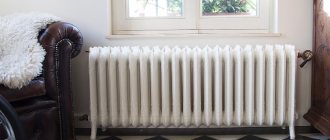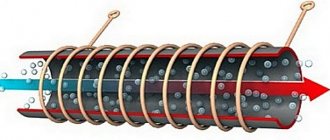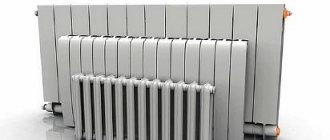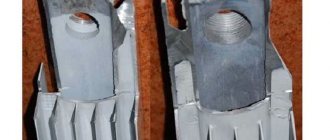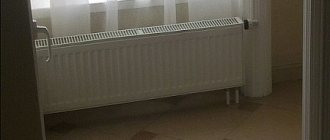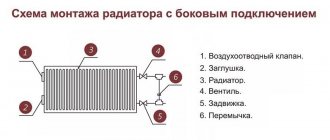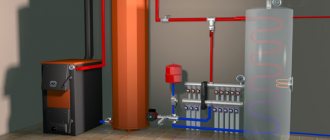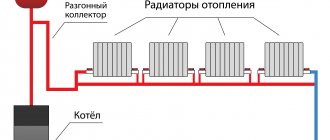Who seeks will always find.
All the news, hurry up to visit us.
New on the site
- How long can the suction line be?
How to test a pump on a bench.
Latest reviews
- Senovad : Hello, Sergey. I'm sorry, but, as a rule, in such cases.
- Sergey : They drilled a hole in a well 4m deep (the water was high, in .
- Senovad : HOW? How.
- Edward : Help me choose a septic tank.
- Senovad : Hello, Andrey. First. Frankly speaking, what .
About the site
I created this site to tell you about my mistakes, to share my experience, my knowledge, my past, present and future projects, my ideas - not only about plumbing. Do not judge strictly. Here I am also learning, and mistakes are inevitable. Ask, I will definitely answer. Share your experience, it will be interesting to everyone.
Features of the MS-140-500 radiator
Cast iron radiators MS-140 with a center distance of 500 mm are designed for heating buildings of any purpose, from private residential buildings to industrial and production buildings.
They have good heat transfer and resistance to aggressive coolants. Cast iron “accordions” stubbornly do not want to leave the heating equipment market, since they are considered the most unpretentious type of radiators. Cast iron batteries are among the most durable. This is due to the physical and chemical properties of the metal.
The main advantage of cast iron batteries is their long service life. Cast iron reluctantly reacts with water and aggressive compounds, resisting corrosion well. The top layer, protected by primer and paint, is also not susceptible to it. Even in the absence of external protection, cast iron practically does not deteriorate or become thinner. It gets to the point that in some cases these radiators can outlast the building itself in terms of service life.
The heat output of MS-140 cast iron radiators with center distance ranges from 140 to 185 W per section. This is a pretty decent indicator, which allows cast iron to successfully compete with other types of heating batteries. Today, cast iron batteries are produced by many domestic factories and are not going to leave the shelves of plumbing stores.
Thanks to modern cast iron casting technologies, the finished products are especially durable and do not require too frequent maintenance.
Differences in the technical characteristics of cast iron heating batteries from other popular types of batteries.
What are the advantages of cast iron radiators MS-140-500?
- Resistance to aggressive coolant - centralized heating systems do not spare even the most durable modern radiators. Cast iron practically does not react with caustic and aggressive compounds;
- Large internal capacity - thanks to this, radiators almost never become clogged or clogged. Also, the internal volume helps reduce hydraulic resistance;
- Long service life - manufacturer's warranty reaches 10-20 years. As for the actual service life, it is up to 50 years and even more, you just need to properly care for the batteries and tint them on time;
- Long-term heat retention - if the heating is turned off, cast iron will retain and release heat for a long time, heating rooms and rooms;
- Affordable cost - the price for cast iron radiators MS-140-500 starts at 350-400 rubles per section (depending on the manufacturer).
Let's list a few disadvantages:
One of the main disadvantages of cast iron batteries is their instability to water hammer; here they are inferior to their bimetallic counterparts.
- Heavy weight is perhaps one of the most important disadvantages. One section weighs over 7 kg, which is why the weight of a 10-section battery is over 70 kg;
- Difficulty in installation - if you can install aluminum or steel radiators yourself, then two or three people will have to work on a cast-iron radiator. In addition, for fastening to the wall you need good, durable fasteners (and the walls themselves should not crumble under the weight of the batteries);
- Lack of resistance to high pressure - cast iron batteries are intended for use as part of autonomous heating systems (installation in low-rise buildings connected to centralized systems is allowed).
We can also highlight as a disadvantage of cast iron batteries MS-140 their high inertia - a lot of time passes from supplying coolant to warming up the system.
Despite the presence of some shortcomings, cast iron batteries continue to be in steady demand - consumers are captivated by the optimal combination of price, quality and technical characteristics.
Cast iron radiators MS-140 can be used as part of autonomous and centralized heating systems with a maximum coolant pressure of up to 9-10 atmospheres. The coolant temperature can reach +120-130 degrees - cast iron remains resistant to such temperature overloads. The main thing is not to subject it to strong impacts, otherwise it may break.
MS-140 radiators can be used in systems with natural and forced coolant circulation. The system can be open or closed - cast iron can work in any conditions. The main thing is that the heating parameters do not exceed the values specified in the passport data. The difficulty in operation is caused only by the need for regular maintenance - monitor the condition of the paint coating and prevent the formation of pockets of corrosion.
Causes of breakdowns
As in the case of the sleigh in the famous saying, the heating system should be prepared for the new season in the summer.
The main causes of problems are:
- Low heating of the aluminum battery when there is no air in it.
- Noises and knocking are heard in the system.
- The aluminum radiator was found to be leaking.
- Plaque appeared at the joints of system elements.
In houses with autonomous heating, these problems can be easily identified by running the system at maximum operating mode. Higher pressure will show the integrity of the structure and allow you to see possible defects in it. In houses with centralized heating, it will not be possible to carry out such work on your own, but you can submit a request to the management service that their specialists have carried out the necessary work.
If during testing the system showed its best side, but problems began at the height of the season, then emergency dismantling of the radiator is required.
To do this you need to do the following:
- The shut-off devices are closed, as is the riser (the media must first be drained from it).
- A container for draining the coolant is installed under the bottom connection.
- Unscrew the lower ball valve so that the water (antifreeze) remaining in the battery drains out.
- The top valve is also unscrewed and the battery is removed from the brackets.
If the question arises of how to repair an aluminum heating radiator if it does not heat, then you should look for the reason for this condition of the device:
- The first thing you need to do is bleed the air from the system and wait until the batteries warm up.
- If nothing has changed, then you will have to dismantle the radiator and check for the possibility of clogging . Sectional aluminum radiators do not hold much coolant. By pouring water into the removed heater, you can calculate whether its quantity corresponds to the parameter stated in the data sheet. If not, then it is not necessary to repair the aluminum heating radiator, but to flush it , for which you should pass water under high pressure through the structure until it brightens.
- If the flow of water did not “cope” with the task, then you will need knowledge of how to disassemble an aluminum heating radiator into sections and do the same work with each element separately . Sometimes, when very dirty, a brush (not metal) is required to rid the battery of thick dirt.
Sometimes the only way to return the batteries to a hot state is to replace the aluminum radiator section or extend them. With the lateral type of connection this will not be difficult, whereas with the bottom or diagonal method you will have to increase or shorten the length of the pipe.
Materials and technical characteristics of cast iron radiators MS-140-500
To tighten the radiator sections, there are left and right threads on the nipple from opposite ends. The material from which the nipples are made is malleable cast iron grade KCh30-6-F according to GOST 1215-79, steel 08 KP or 08 PS according to GOST 1050-2013.
The nipple is installed between the sections. Its rotation is carried out using a key with a straight tip. Due to the fact that the nipple is threaded in different directions, the sections are pulled together. It is accessed through the open radiator hole.
The resulting connection is sealed using an annular gasket. Gasket material – heat-resistant rubber ITP or ITC, corresponding to TU 38 105376-82, or ring 9833-73 / 18829-73.
If it is not possible to install a rubber gasket, it is possible to seal the joints using tow.
Tow is impregnated with red lead or drying oil. The end of the radiator battery is closed with a plug made of gray cast iron SCh 10 GOST 1412-85. Table 1. Technical characteristics of radiators MS-140-500
| Manufacturer / Characteristics | Minsk Heating Equipment Plant | OJSC "Santekhlit", Bryansk region | Nizhny Tagil boiler and radiator plant Novosibirsk (Russia) | Lugansk Foundry and Mechanical Plant (Ukraine) | |
| Marking | MS-140-500 | MS-140-500-0.9 | MS-140-M2-500 | MS 140/500 | MS-140-M4-500-0.9 |
| Height, mm | 588 | 590 | 580 | 588 | 588 |
| Width, mm | 108 | 98 | 90 | 93 | 98 |
| Depth, mm | 140 | ||||
| Weight, kg | 7,12 | 6,25 | 6,25 | 7,1 | 6,74 |
| Distance between hole centers, mm | 500 | ||||
| Through hole size, inch | 5/4 | ||||
| Water volume in section, l | 1,45 | 1,45 | 1,4 | 1,45 | 1,33 |
| Number of channels in a section | 2 | ||||
| Permissible coolant temperature, degrees. | 130 | ||||
| Heat transfer value of the section, W (t=70 degrees) | 185 | 160 | 160 | 160 | 184 |
| Warming up area per section sq.m. | 0,244 | ||||
| Permissible coolant acidity, pH | 6–9 | ||||
| Test pressure, MPa | 1,5 | 1,5 | 1,8 | 1,5 | 1,6 |
| Working pressure, MPa | 0,9 | 0,9 | 1,2 | 0,9 | 0,9 |
These models can be used with almost any type of coolant that meets acceptable acidity standards.
Differences between left-handed and right-handed threads
One of the main characteristics of a screw connection is the direction of the thread when the parts rotate. The full operation of the mechanism and the integrity of any structure depend on the quality of the connections, which are considered a responsible and important element.
In mechanics, there are two main types of fastening products. With standard threads, the lines of threads are removed clockwise towards the viewer. With a left-hand thread, the protrusions on the screw approach it from the left, moving counterclockwise.
Thus, the direction of rotation of the turns (helix) on the screw makes it possible to distinguish a right-handed thread from a left-handed one. On hexagon bolts, studs, nuts and fittings, left-hand threads are marked with the letter L.
Methods for installing a cast iron radiator
Since cast iron radiators have considerable weight, when choosing a model it is better to think about the installation method in advance. The battery can simply be placed on the legs. Many designer radiators are already available with legs. If we are talking about other models, then you can also select and purchase legs for them separately.
If you plan to attach the battery to the wall, then it is recommended to do this on a load-bearing wall. You can mount the heating device on the partition, but first it must be further strengthened. To do this, the fastenings must be as reliable as possible. It is better to use hooks or brackets.
Installation of a cast iron radiator
Sources
- https://teplosten24.ru/teplootdacha-chugunnyh-radiatorov-ms-140.html
- https://fb.ru/article/281193/ms—-radiator-chugunnyiy-harakteristiki-obzor-vidyi-i-otzyivyi
- https://fb.ru/article/283114/ms–m—-radiator-chugunnyiy-harakteristiki-preimuschestva-i-nedostatki-proizvoditel
- https://gopb.ru/radiatory/kakie-luchshe-chugunnye-radiatory-otopleniya-ms-140m-500-ms-110-500-ms-110-300-texnicheskie-xarakteristiki/
Cutting with circular knives
Only large round seals can be produced using this method. In the process of work you will need fairly cheap and high-performance equipment. Cutting is carried out with standard blades. Therefore, the production of gaskets of this type can be carried out independently and in any volume. Radiator leaks are often caused by a damaged gasket. And if you don’t know what to do if the heating battery leaks, first of all you should pay attention to the gaskets.
Why else should you choose a cast iron battery?
Heating devices made of cast iron also provide radiant heating, which distinguishes them favorably from steel and aluminum devices. Heat is distributed into the environment by infrared radiation. Objects begin to transfer heat into the air space, acting as additional heating sources.
If necessary, such devices can be disassembled when it is necessary to install a device of the required thermal power. Sections can be added or removed if necessary, and the internal walls can also be cleaned. Another advantage is the affordable price, which varies from 400 to 500 rubles. As you know, price is a factor that sometimes influences the final choice of the consumer. If you are still undecided which radiator to prefer, then it is necessary to clarify the fact, which indicates that some positive qualities can sometimes look like disadvantages. They will be discussed below.
Thermal molding
In this case, you will need an injection molding machine with a mold for casting products. The cost of a molding press is quite high, so in order to make production economically feasible, the production of gaskets using this method must be large-scale or even mass-produced.
The production of products in small batches using this technology is relevant only if they cannot be produced in any other way. It is noteworthy that only PVC seals are produced by thermoforming.
Video
The video contains instructions on how to disassemble, clean and assemble a Tefal iron yourself:
About the author:
Electronic engineer with many years of experience. For several years he was involved in organizing the repair of household appliances, including washing machines. Loves sport fishing, water tourism and travel.
Found a mistake? Select it and click the buttons:
Ctrl + Enter
Interesting!
Astronauts, while in Earth orbit, solve the problem of dirty things using an original method. Clothes are dropped from the spacecraft and burn up in the upper atmosphere.
How to choose a cast iron radiator
What radiator performance characteristics should you pay attention to when choosing radiators? First of all this:
- operating pressure;
- operating temperature in the heating system for which heat transfer is calculated;
- heat transfer;
- heat-emitting surface area;
The first of these indicators determines the coolant (water) pressure that the radiator can withstand. The higher the number of floors of a building, the stronger it should be. The second indicates at what temperature the coolant is supplied to the radiator and at what temperature it leaves it for subsequent heating. So the indicator 90/70 means that the water entering the first section of the battery has a temperature of 90 degrees. and coming out of its last section - 70 degrees. Heat transfer is an indicator indicating how much heat the radiator section gives off during the time the water in it cools from the inlet temperature (for example, 90 degrees) to the outlet temperature (for example, 70 degrees).
The shape of the purchased radiator deserves special attention. It is no secret that the prejudice against cast iron radiators is caused by the fact that when they are mentioned, many people remember the “cast iron accordion” under the window, which they have become accustomed to since childhood. Indeed, the usual “finned batteries” have a small and ineffective heating surface area (heat transfer) - for example, for a section of the familiar MS 140 radiator, this figure is 0.23 sq.m.
Part of the heat of the incoming coolant is lost “on the way” from the heating boiler to the water heating battery, because massive supply pipes are used for such systems. In addition, to heat water to a design temperature of 90 degrees. Only high power steam boilers are suitable. Therefore, in private homes the heating system sometimes operates at a lower temperature.
However, modern cast iron radiators, both in appearance and, accordingly, in parameters, can differ significantly from their “accordion” predecessors. While retaining all the advantages of traditional cast iron batteries, it is devoid of many of their disadvantages. Thus, the Minsk-made 1K60P-500 radiator is assembled from flat plates, each of which has a small heating area (0.116 m2) and low power (70 W).
However, a radiator assembled from them is essentially a heating panel, which (unlike finned batteries) produces a wide directed heat flow. Other manufacturers also provide a wide selection of such radiators.
The advantage of modern cast iron radiators is that many models allow batteries of the required power to be assembled from separate sections.
Radiators sold assembled (for example, Conner, STI Breeze and some others) are formed from a number of sections designed for rooms of various sizes based on an engineering calculation of the required thermal power per square meter of room.
For example, you can purchase one radiator of 4-6-8-12 sections or two radiators of 4 (6, 8 sections).
Classification
Plugs for heating radiators can be divided into groups according to several criteria.
Material
As a rule, it corresponds to the radiator material:
- For a cast iron battery, a cast iron radiator plug is used;
- For sectional steel and bimetallic radiators, steel pipe fittings are purchased.
However: for aluminum batteries, with rare exceptions, not aluminum, but the same steel products are used. The aluminum plug is too easily damaged when screwing in and installing the trim; in particular, 1/2-inch diameter threads cut into aluminum can be stripped with very little force.
Steel fitting for aluminum and bimetallic batteries.
Thread
It can be right-handed (screwed in clockwise) or left-handed. As a rule, the left plug for a cast iron radiator and the steel plug made in Russia for aluminum/steel/bimetallic devices are marked with the letter “L”.
If there is no marking, it is not difficult to identify the type of thread: it is enough to trace one of its threads over a couple of turns.
Functions
With a blind plug, everything is simple and clear: its only function is to plug the threads of the end section.
The pass-through radiator plug is used to connect the insulation and/or piping elements to the heating device. In fact, it is an adapter for a thread of a smaller diameter. The thread on the section depends on the material of the heating device:
| Battery Type | Thread size |
| Cast iron | DN32 (1 1/4 inches) |
| Aluminum, bimetallic | DN25 (1 inch) |
The diameter of the thread connected to the passage plug can also be different:
| Battery Type | Thread size |
| Cast iron | DU15, DU20, DU25 |
| Aluminum, bimetallic | DU15, DU20 |
How much does a section of an old-style cast iron battery weigh?
The classic cast iron accordion battery can be found everywhere. There is no single weight for such a battery, because several types of factory designs were produced. The cast iron radiator MS-140 had two varieties regarding the center distance: 300 mm and therefore 500 mm. The average weight of one radiator fin is 5.7 kilos. But if we talk about the MS-140 (500) radiator, then the weight of the fin reaches 7.1 kg.
The battery installation must meet the following requirements:
- The battery fins must be strictly vertical;
- The center of the radiator from the center of the window should not deviate more than 2 cm;
- The distance from the floor to the radiator itself must be at least 60 mm, otherwise it will be extremely difficult to clean underneath it.
The distance from the plane of the radiator to the window sill should not be more than 5 cm. This will be convenient, if necessary, to repair the battery and care for it. And dismantling will be convenient when it’s time to change the battery.
Installation instructions
The MS-140-500 radiator, the installation instructions for which will be described below, can be chosen by you as a heating device. The most difficult stage of the work will be connecting the device to the general house system. Therefore, you should contact the housing office that maintains the house.
You should first prepare the place where the radiator will be installed. For this purpose, fastenings are mounted at one level, where the cast iron battery will be hung. You can paint the radiator only after installation and connection, otherwise the work will have to be done twice. The sections should be connected to each other using nipples, which are a cylindrical coupling with counter-directional threaded sections. Gaskets are installed between the sections. To engage with the splines, special beads located on the inner surface of the nipple will be required.
Preparatory work
In order to disassemble the cast iron body, it must first be removed from its mounting on the wall. The hooks on which the battery is suspended are removed, then you need to disassemble the taps or couplings with which the radiator is connected to the heating pipes.
The weight of one assembly of 8-10 sections can easily exceed a hundred kilograms, so the battery is lifted to its end and in small “steps” it is moved to the place where it is planned to repair the radiator or simply disassemble it.
If the cast iron battery is relatively new, then a platform with an impact-resistant coating will be sufficient, for example, a sheet of chipboard can be laid on the floor. To disassemble an old cast iron heater, you will need a place where you can work with a torch and a heavy crowbar.
Main advantages
Cast iron radiators, the price of which is one of the advantages, were invented quite a long time ago, but to this day they continue to be in demand, due to their operating efficiency and corresponding quality characteristics. In addition, a better option in this line has never been invented.
But any device, like a cast iron battery, has its own advantages and disadvantages, which will be discussed below. Among the advantages are:
- unconditional reliability;
- high heat capacity;
- Possibility of use in autonomous and central heating systems.
If you want to choose a truly high-quality and durable device, then you should prefer the MS-140M-500 - a cast iron radiator, the characteristics of which you could read above. It is ready to serve for more than 50 years, this is exactly the period that manufacturers give for the operation of this device. If you take proper care of the unit, it will last much longer.
These radiators are also preferred for the reason that cast iron has a high heat capacity. This characteristic is important when, after a shutdown, there is a need to retain heat indoors for a long time. These devices are ready to withstand pressures of up to 9-12 atmospheres, which is important for devices operating in central heating systems, where water hammer is frequent and can damage the integrity of batteries with thin walls. This is why the cast iron version is so common in apartments in multi-storey buildings.
When the assembly has been carried out correctly, the cast iron radiator will easily withstand water temperatures up to 130 °C. In this case, the coolant can be of any quality. MS-140M-500 is a cast iron radiator, the characteristics of which must be studied before purchasing the product; it has fairly wide internal channels that rarely become clogged. This feature makes it possible to prevent sections from breaking during hydraulic shocks.
Application of punching knives
The operating principle of this method is similar to die cutting, but in this case a simpler and less expensive tool is used. The production of seals in this way is inexpensive and quite fast. However, the pants are quite short-lived, so this technique is used for the production of small and medium-sized batches of gaskets.
Technical characteristics of MS 140 batteries
For the manufacture of this type of radiators, an entire GOST 8690–94 was developed at one time, regulating all parameters of the product. In accordance with it, 5 standard sizes of batteries were produced with center distances of 300, 400, 500, 600 and 800 mm. The table below shows cast iron heating radiators with technical characteristics of dimensions in accordance with GOST 8690.
Previously, all standard sizes of these devices could be seen not only in apartments, but also in industrial or administrative buildings. It is advisable to review the characteristics of the two most popular standard sizes: 300 and 500 mm, which are still in demand. Other modifications are now very rare, and they are made only to order.
The main technical characteristics of the cast iron radiator MS 140 with center distances of 300 and 500 mm are reflected in the following table.
Having studied all the characteristics, we can draw conclusions about the advantages and disadvantages of the heating devices in question. Their advantages are as follows:
- Durability. It is at least 30 years old.
- Heat dissipation. Despite its outdated design, the cast iron radiator MC 140 shows good thermal power values.
- Unpretentiousness. The gray cast iron from which the devices are made is not subject to corrosion and easily tolerates poor coolant with a high oxygen content.
- Low maintenance. It is not superfluous to flush the channels of the product once every 2 years, but if this is not done, then the MS 140 will continue to work safely. Only the heat transfer rate will begin to decrease.
- Inertia. It is both a plus and a minus of batteries. The advantage is that after the heating is turned off, the device continues to radiate heat into the room for a long time.
- Affordable price.
Now about the shortcomings, of which there are also many. The same inertia of the devices causes them to heat up for a long time and excludes the possibility of regulation using thermal heads. There are others:
- Large coolant capacity. This affects the rate of heating and cooling of the system, and also forces a lot of thermal energy to be spent on heating a large volume of water.
- The considerable weight of the products affects the installation of radiators. They are very difficult to mount on walls made of porous lightweight materials, which are very popular nowadays.
- Low operating pressure threshold. This makes it impossible to install it in high-rise building systems.
- Fragility. The wall-mounted cast iron radiator MC 140 500 is shock-resistant because it has thin walls. It cracks at the slightest freezing of water from frost.
- Unpresentable appearance compared to more modern analogues of cast iron batteries.
Attaching the toilet to the floor on tiles: step by step
The installation process will vary slightly depending on the type of installation you choose. For example, to install a toilet with an open mount, you need to do the following:
- We install the structure in the intended location.
- Using a marker, make marks on the tile where the fasteners will be installed. The marker must be vertical, otherwise there is a risk of the marks shifting, which will cause incorrect installation.
- We move the toilet. In the place where the marks remain, we make holes (use a drill).
- We take a core and scratch the tile coating (this is necessary to avoid the drill from sliding on the tile).
- First we use a drill designed for glass.
- As soon as we have overcome the glass layer of the tile, we take a drill for concrete.
- We make a hole of the required depth. The size depends on the mounts purchased.
- The finished hole is cleared of debris.
- Fill the hole with sealant. This will protect the installation from moisture.
- After adding sealant to the holes, you can insert the installation.
- Now we install the toilet. It is also necessary to make a strip of sealant along its contour to protect the base from moisture.
- Elements are inserted into the mounting holes. We twist them.
- To protect the installation from water, as well as to give them an aesthetic appearance, plugs can be placed on the bolts.
- The remaining sealant is removed with a staple.
If we chose internal fastening, we do the following:
- Before fixing the product, it is necessary to make holes for water supply and sewerage.
- As in the open installation method, work begins with creating marks on the tiles.
- Drill the necessary holes. We place hidden fasteners on the floor.
- After installing the fasteners on the floor, they must be secured with bolts.
- We install the empty part of the toilet onto the fasteners.
- We secure the structure with bolts through the side holes.
- You should not tighten the bolts all the way, as there is a chance that you will have to slightly adjust the position of the toilet to secure it to the water and sewer line.
Anyone can install a toilet on tiles, the main thing is to follow the instructions.
Required Tools
It is impossible to disassemble the cast-iron case with bare hands; without a tool, the battery can be broken with a sledgehammer or split if handled carelessly and dropped on the floor. To work, you will need at least four types of equipment:
- A special key with a square head for unscrewing nipples;
- Socket wrench for turning out plugs;
- Grinder with cutting wheels;
- Gas burner with reducer and cylinder.
Nipple keys
In addition, you will need a heavy plumber's hammer, chisel, tow, kerosene or brake fluid. All this will be needed in order to try to disassemble the sections with minimal damage. When rebuilding old batteries, the plugs and nipples still need to be replaced, so sometimes it's easier to cut them out than to try to unscrew them.
Peculiarities
So, what conclusions can be drawn by studying the technical characteristics of the MS-140-500 cast iron radiator?
- Slow heating and equally slow cooling make the device an excellent choice for an autonomous system with a solid fuel boiler. Inertia will smooth out fluctuations in coolant temperature during infrequent kindling.
- Wide internal channels of sections and collectors, coupled with a large diameter of the connecting thread, will allow it to be used in gravity systems. Thanks to these features, MS-140 will create minimal hydraulic resistance to flow.
- Despite the many years of use of this heating device in central heating systems, the characteristics of the cast iron radiator MS-140M-500 do not allow us to recommend it for these purposes with a light heart. The key word is water hammer: at the front of the area of increased pressure spreading along the contour there can be 20 or 25 atmospheres, for which the device is not designed. Yes, water hammer is an abnormal situation, but, believe the author’s experience, it is quite common in the real world.
Consequences of water hammer.
Properties of radiators MS 140
Simplicity of installation and repair, high performance characteristics, as well as good heat dissipation - all this makes MC 140 radiators a popular product among both wholesale and retail customers. In addition, similar products were installed back in Soviet times. Therefore, they have been repeatedly tested for strength and serve their owners to this day, enjoying their trust.
The peculiarity of sectional cast iron radiators of this brand is their resistance to aggressive environments. In addition, they have a classic design that is appropriate in any interior. And such equipment can be used in heating systems not only in residential buildings, but also in public and industrial facilities.
Advantages of devices
It is worth noting the following advantages of the device:
Characteristics of Breeze 500
- Expanded cross-section of water channels, due to which the service life of the radiator is significantly increased.
- High level of thermal conductivity, as well as durability and reliability. Cast iron is a wear-resistant material that is not harmed by small stones or various debris found in the coolant. For high-quality radiators, the service life can reach up to 50 years. However, manufacturers talk about 30 years of reliable use without cleaning or repair.
- Good anti-corrosion characteristics. They are ensured due to the fact that during use the surface of the cast iron radiator is covered with “dry rust”, which does not give corrosion the slightest chance.
- Convenient ability to replace sections.
- Cast iron under no circumstances can cause electrochemical corrosion. This means that there will be no problems when using such radiators with plastic or steel pipes.
In addition, cast iron batteries are best suited for Russian consumers, given the qualitative composition of the coolant circulating through centralized heating networks. Not every aluminum or bimetallic radiator can withstand the quality of the coolant for at least 10 years, but cast iron ones do this for more than 30 years.
Flaws
Decorative pattern
Among the disadvantages are:
- solid weight of the structure;
- high heat inertia;
- possibility of damage to the system due to water hammer.
In addition, due to the large mass of the radiator, difficulties may arise during the installation process or when transporting the equipment.
Selection of coolant
How to fill bimetallic radiators in those rare cases when they are used in an autonomous heating circuit?
In the vast majority of cases, plain water is used as a coolant. In addition to the fact that the cores of the bimetallic sections are sufficiently resistant to corrosion, when the circuit is filled with water, their contact with atmospheric oxygen is completely excluded. At the same time, in an oxygen-free environment, the appearance of rust is unrealistic.
In cases where the heating circuit is likely to stop at sub-zero temperatures, it is practiced to fill bimetallic radiators with non-freezing coolants:
- An aqueous solution of propylene glycol,
- Antifreeze,
- Transformer oil.
Cast iron radiators MS-140
i http-equiv="Content-Type" content="text/html; ″>d=”breadCrumb”> Home page»Radiators»Cast iron radiators» MS-140
| MS-140-500 price list MS-140-300 price list |
MS-140 is a two-channel heating device consisting of separate cast iron sections connected to each other by nipples with rubber or paronite gaskets. The large cross-section of the channels allows the coolant to circulate inside the radiator without additional effort, which makes it possible to use it in systems with natural circulation, in the so-called gravity heating systems.
Cast iron radiators have significant thermal inertia, i.e. They react poorly to changes in coolant temperature, take a long time to heat up and take a long time to cool down, so the use of this type of heating devices in heating systems where a weather-dependent or other thermoregulation mode is used is inappropriate.
MS-140 heating radiators are quite heavy and have a rather unattractive design, however, the demand for these heating devices does not weaken due to their availability, both in terms of price and in terms of ease of maintenance and durability. They are supplied primed or painted on pallets with 10 radiators each: 9 radiators in 7 sections and one radiator in 4 sections. If it is necessary to assemble heating devices with a different number of sections from the base, subsequent pressure testing of the radiators is required. Depending on the manufacturer, MS-140 radiators can have an operating pressure of up to 12 atm, a test pressure of up to 18 atm, a nominal heat flux of one radiator section of up to 175 W, and a maximum coolant temperature of up to 130°C.
The main manufacturers and suppliers of cast iron radiators MS-140 to the Russian market are the following enterprises:
Minsk Heating Equipment Plant - the most popular product on the Russian market is Minsk cast iron radiators MS-140. However, in addition to standard radiators, the plant produces heating devices of the following modifications: cast iron design radiators 1K60P-500, radiators with reduced front clearance between sections and improved design 2K60, 2K60P, 2K60PP, 2KPM-90x500, 2KP100-90x500. The above heating devices differ from traditional MS-140 radiators, in addition to their design, in their smaller depth, capacity and higher operating pressure.
Lugansk Foundry-Mechanical Plant is an enterprise that also produces a wide range of competitive products of European quality: traditional cast iron radiators MS-140 with center-to-center distances of 500mm and 300mm; compact, similar in design to KONNER cast iron radiators, heating devices RK-1-100-500; compact and lightweight three-channel cast iron radiators MS - 100 M1 3KP 500 and MS - 100 3KP 300 with center-to-center distances of 500 mm and 300 mm, respectively.
Cheboksary Cast Iron Radiator Plant - the plant produces both traditional MS-140 radiators and modified CHE.RAD radiators, which have a more attractive design, compact size and lower capacity. A special feature of these heating devices is the presence in the model range of 2- and 3-channel radiators with a depth of 102 mm and 120 mm, respectively.
Lyubokhonsky Iron Foundry - produces cast iron radiators MS-140, MS-110, MS-85. A special feature of the model range is the presence of radiators with a depth of 110mm and 85mm. These are compact heating devices with a higher - 12 atm - excess pressure and an updated design. Radiators are supplied primed and painted.
Nizhny Tagil Boiler and Radiator Plant - the enterprise produces traditional radiators MS-140 with a center-to-center distance of 500mm and 300mm - MS-140M2-500 and MS-140M-300 with heat output of 160W and 117W, respectively, as well as a model of cast iron sectional radiators T90 - heating devices with improved design, depth 90mm, center distance 500mm and heat output 127W per section. All NTKRZ radiators are supplied assembled in 4 and 7 sections in a primed form.
| Conner | Guratec | Sti | Che.Rad |
| Home | 2003 kck20 |
Methods for calculating paint coverage area
You can find the necessary information about the paint coverage area in the technical description for the model. Usually for domestic equipment it is indicated as “heating area” or otherwise if it is an imported radiator.
The most popular type of heating device is MS-140. This is a classic for most older apartments. The length of one section is 9.3 cm, height is 58.8 cm. The area is 0.24 m². Based on this, you can find out the total area of the battery. The area of the section is multiplied by their number. The result is a number equal to the area of the painted surface of the cast iron radiator. It is better to always round up the result and take into account paint consumption with a small margin for taps, couplings, adapters, etc.
A more modern or modified model of the heating device has a painting area of cast iron radiators of approximately 0.208 m2. Accordingly, less coloring material will be needed.
Now many Internet sites have special online calculators. With their help, you can independently calculate the required indicator. To do this, you just need to enter the following parameters in the appropriate lines:
- radiator marking according to technical documentation;
- number of sections, their length and height.
After this, the program will make the necessary calculations of the paint area and give the desired result.
As you can see, calculating the area of heating radiators for painting is not at all difficult. After this, you can confidently begin the reconstruction of one of the main interior elements.
There are many types of heating equipment - these are steel, aluminum, metal, bimetallic, cast iron radiators, each section of the radiator has its own characteristics - all of them have both their advantages and disadvantages.
Heating Devices LLC, which produces refurbished cast iron radiators, retains all standard characteristics in its products that meet GOST 31311-2005. The manufactured products are distinguished primarily by their lower cost compared to similar products.
Each radiator section has a thermal power of 160 W. Long-wave thermal radiation enters the room, which makes up 35% of the total heat flow, due to which the lower part is uniformly heated, and the resulting convention with the help of the other 65% of the heat flow prevents the high temperature from rising in the upper part of the room.
The corrosion resistance of cast iron suggests the increased durability of cast iron radiators. Cast iron heating radiators can be used for up to 50 years, which is also not a limit for them. Gravity circulation systems can use such radiators.
Disadvantages of heating cast iron batteries:
The production and installation of such batteries is a rather labor-intensive process; the weight of a section exceeds 7 kg. It is impossible to adjust the amount of heat transfer from the radiator using thermoregulation heads; this is due to the fact that cast iron has a large heat capacity, and the sections have a large capacity. The increased heat capacity will allow you to retain heat for a certain period of time even after the heating is turned off.
Heating cast iron radiators of the MS-140-500 series - they heat residential, public buildings, industrial premises, the coolant has a temperature of up to 130 degrees C, the operating excess pressure is within 0.9 MPa.
Cast iron radiator - sectional two-channel type. The section has a length of 93 mm, a radiator height of 588 mm, and a depth of 140 mm. One section has a heating surface area of 0.244 m2, and a nominal heat flux of 0.160 kW. One section has a capacity of 1.45 liters. and weight including nipples and plugs of 7.1 kg. The nipple hole has a thread - G1 1/4.
The MS-140-300 series of cast iron heating radiators is intended for heating residential, public and industrial buildings with low window sill heights, the coolant temperature is 130 degrees C, the operating excess pressure is 0.9 MPa.
Radiator Specifications:
Radiator of sectional two-channel type. The section has a length of 93 mm, a height of 388 mm, and a depth of 140 mm. The heat flow has a nominal value of 0.120 kW, and the capacity of one section is 1.11 liters, weight is 5.7 kg. Threaded nipple hole - G1 1/4.
Heating cast iron radiators MS-90-500 - heat industrial, public, and residential premises. Their technical parameters:
Sectional two-channel type. The section has a length of 78 mm, a height of 571 mm, and a depth of 90 mm. Heat flow - 0.160 kW. The capacity of one section is 1.45 liters. Nipple hole thread - G 1/4-B.
Radiator nipple: functions, replacement, sealing
What specific functions does the nipple for heating radiators perform? How is it built? How to replace a broken nipple and how to ensure the tightness of the connection after its replacement is completed? In this article we will try to answer these questions.
Nipple rupture
The consequences of a nipple rupture are much more unpleasant. If in the first case the bad thing that threatens you is a small puddle under the battery, then disconnecting one of the collectors is fraught with flooding of your and neighboring apartments with warm water with a huge amount of silt and sand.
What could be the reason for the rupture of a sufficiently strong nipple?
- Connection overtightened during assembly. As already mentioned, sections of steam expand when heated; As soon as the coolant temperature rises, the barely visible crack will expand and turn into a source of significant trouble.
- Water hammer. This is the name of a wave propagating in a virtually incompressible medium, created by an abrupt stop in flow when the valve of a screw valve is torn off, the cheek of a valve falls, or simply the shut-off valve is suddenly closed. The pressure at the flow front during water hammer can be about 20 – 25 atmospheres.
Reference: cast iron radiators are designed for a working pressure of 9-12 atmospheres, aluminum radiators - 6-16.
Sealing
How is the tightness of intersection connections ensured?
- Until the mid-20th century, plumbing flax with red lead was used for this purpose. The paint prevented natural fiber from burning out at high temperatures and rotting when moistened. The winding was placed near the nipple in a tight bundle and was securely pulled together when connecting the sections.
- For the next couple of decades, during the factory assembly of cast iron heating devices, gaskets made of paronite (hard heat-resistant rubber) were used. The solid resource of this material is combined with low elasticity, requiring enormous tightening force.
At the moment, silicone gaskets are used along with paronite for sectional aluminum, cast iron, steel and bimetallic batteries. They are distinguished by their toroidal cross-section (to put it simply, they look like a narrow donut from the outside). Silicone remains elastic for a long time and does not require enormous tightening force.
But: when assembling an intersection joint with your own hands, it is quite difficult to center the gasket so that it does not squeeze out beyond the boundaries of the sections. It is more ergonomic to use silicone rings with sections that have annular grooves on the collector planes.
Replacement
How to replace the gasket between sections or the intersection nipple?
Here are replacement instructions for the case when the problematic connection is close to the end of the radiator:
- Once the coolant has been discharged, the blind plugs are unscrewed.
- On the radiator key, a marker marks the distance to the problematic connection.
- The key is inserted into the radiator and turned until it engages with the ribs of the nipple.
- The nipple is turned clockwise (from the side of the blind plug the thread is invariably left-handed) one turn.
- The operation is repeated with the second nipple. Then they turn away one by one: the distortion can jam the connection or nipple.
After replacing the defective part, assembly is carried out in the reverse order. If the problematic connection is close to the supply line, the radiator is dismantled and disassembled on the floor.
When repairing sectional radiators, it is useful to know a few subtleties.
- If the connection does not respond to the key, warm up the section collector with a blowtorch or a hair dryer. Due to thermal expansion, the force required for disassembly will become fully feasible.
- If you don’t have ready-made radiator gaskets on hand, you can make them yourself. Cut the unnecessary inner tube, trace the outline of the old gasket on it with a ballpoint pen and cut out a new gasket with simple scissors.
Calculation of the number of sections
Accurately determining the number of sections in a heating battery is a long process. You need to take into account the region, the material of the walls, what kind of windows and doors there are, how many windows are in the room, what their area is, whether the room below is warm or cold, etc. If you need an exact calculation method, look here, but you can roughly calculate based on the area of the room. It is believed that on average 100 W of heat is required to heat 1 m2 of area. Knowing the area of your room, determine how much heat will be needed: multiply the area by 100 W. Then divide by the thermal power of the selected radiator model.
For example, in a room of 12 m2 we will install MS-140M-500-0.9 from the Bryansk plant. Thermal power of the section is 160 W. Calculation:
- Total heat required is 12m2 * 100 W = 1200 W
- How many sections are needed 1200 W / 160 W = 7.5 pcs. We round (always up - it’s better if it’s warmer) and we get 8 pieces.
Useful tips
Having learned all the advantages that cast iron radiators have, you should not immediately go to the store. You must first calculate the number of sections required to heat a certain area of the room.
Their number largely depends on the size of the room, but there are several other factors:
- Floor.
- Zoning.
- Presence of double glazed windows in the room.
- Ceiling height.
- Number of windows. If there are several of them, then radiators should be placed under each of them, which will significantly reduce heat losses.
Battery in the interior
For corner rooms, it is recommended to give preference to more powerful radiators and make several additional sections. After all, such rooms are characterized by additional heat losses, which affects the comfort of residents.
To calculate the number of sections, you need to multiply the area of the room by 100 and divide by the heat transfer of one section. The resulting number should be rounded up to ensure a power reserve.


